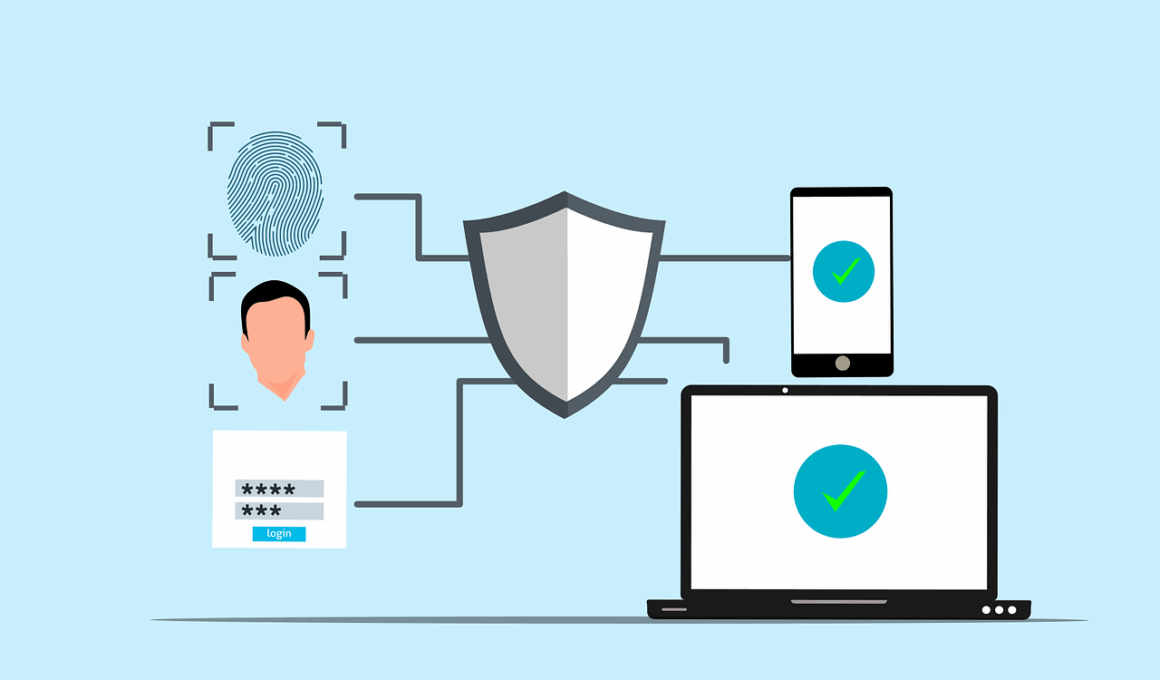Enhancing Security in Digital Wallets with Adaptive Technologies
Digital wallets have become integral to modern financial transactions, enabling users to make payments seamlessly. However, as adoption increases, so does the need for robust security frameworks. Adaptive technologies are crucial in addressing the vulnerabilities in digital payment systems. These innovations not only enhance user experience but also mitigate the risks associated with financial fraud. Security breaches can undermine consumer trust, resulting in significant financial losses for both users and businesses. Therefore, it is essential to implement layered security protocols within the digital wallet ecosystem. Two-factor authentication (2FA) and biometric screening are among the first lines of defense. This ensures that only authorized users can access sensitive financial information. Moreover, utilizing machine learning algorithms can help monitor transaction patterns and detect anomalies effectively. This proactive approach allows for immediate responses to suspicious activities, safeguarding both user data and financial assets. Companies must prioritize investing in such technologies and continuously update their systems to outpace emerging threats. Embracing a culture of security awareness can empower users, fostering safer online transactions and confidence in digital financial platforms.
As users increasingly shift towards online payment solutions, mobile wallets are becoming more prevalent. However, this convenience has become a double-edged sword, as cybercriminals constantly seek to exploit vulnerabilities in these digital platforms. One way to combat these threats is by implementing adaptive security measures that evolve in response to changing risk profiles. By leveraging advanced analytics, organizations can identify suspicious behaviors in real-time, allowing for immediate action to prevent fraudulent transactions. Additionally, regular vulnerability assessments and penetration testing can help identify weaknesses in the system before attackers can exploit them. User education also plays a pivotal role in maintaining digital security. When consumers understand the importance of secure password practices and recognize phishing attempts, they become an additional layer of defense. Furthermore, integrating behavioral biometrics can establish unique user profiles based on interactions with the wallet interface. This innovation can make it more challenging for unauthorized users to gain access while providing a frictionless experience for legitimate users. In this ever-evolving landscape, financial institutions must stay ahead of threats by continuously adapting their security strategies in an agile manner, ensuring digital wallets remain a secure payment option.
The Role of Machine Learning
Machine learning is revolutionizing how digital wallets safeguard user data and transactions. By analyzing transaction data from millions of users, algorithms can recognize patterns and predict potential fraud before it occurs. This technology enhances the overall security framework of digital wallets. It enables automated responses to anomalies, such as excessive spending or unfamiliar transaction locations. These responses can include locking the account temporarily or generating alerts for the user to verify transactions. Additionally, machine learning can identify trends within user behaviors, which can aid in enhancing the personalization of security features. As users engage with their wallets, continuous learning algorithms refine their understanding of what constitutes normal behavior. Adaptive technologies can create dynamic risk profiles, adjusting security measures based on user context and previous interactions. This means that a user traveling abroad might face different security protocols than when conducting routine transactions at home. The application of machine learning also extends to detecting phishing schemes that target users through deceptive emails and websites. By employing such smart technology, digital wallets can proactively defend against threats and create a safer transactional environment for all users.
Another critical aspect of enhancing security in digital payments is the implementation of end-to-end encryption. This technology ensures that sensitive user data is protected at every stage of the transaction process. From the moment a user enters their payment information until it reaches the merchant, encryption acts as a robust shield against interception. As cyber attackers constantly seek to exploit weak points in digital communication, the implementation of secure encryption protocols becomes even more essential. Moreover, tokenization can further enhance security by replacing sensitive data with a randomly generated string of characters. This means that even if data is intercepted during transmission, it remains worthless to the attacker. Additionally, organizations should consider adopting secure coding practices to fortify their applications against common vulnerabilities such as SQL injection. Regular code reviews and updates can significantly reduce security risks associated with application weaknesses. Engaging with cybersecurity partners to provide audits and assessments of their systems can also bolster existing security measures. By continually focusing on encryption and coding practices, digital wallets can establish a fortified environment, ensuring comprehensive protection for their users and enhancing user confidence in digital transactions.
User-Centric Design and Security
Designing user-centric digital wallets involves not only ensuring usability but also integrating security features seamlessly into the experience. Users should find it easy to recognize and utilize security features without feeling overwhelmed or confused. Simple and intuitive interfaces can promote better security practices, ensuring that users understand the steps they need to take to protect their information. For instance, users should be easily guided through the process of setting up two-factor authentication or biometric verification, with clear instructions provided. Moreover, incorporating context-sensitive help can assist users in making informed decisions about their security settings. An essential component of user-centric design is providing feedback on security features, such as notifying users of successful logins or any changes to authentication settings. This transparency fosters trust and encourages users to engage with security options actively. Regularly updating the design based on user feedback and evolving security threats can help maintain an engaging experience while reinforcing safety. Thus, user-centric design should be a priority for digital wallet providers aiming to build trust and encourage users to utilize the full range of security offerings available.
Collaborations between financial technology companies and cybersecurity firms can lead to immense advancements in digital wallet security. By pooling expertise in both areas, organizations can develop comprehensive security frameworks tailored for digital transactions. This collaboration ensures that technological innovations are consistently aligned with security measures capable of combating evolving cyber threats. For instance, cybersecurity experts can guide fintech companies in implementing robust security protocols while leveraging their insights into potential threats. Furthermore, joint research initiatives can enhance awareness and understanding of common vulnerabilities within mobile payments. Educating users about these vulnerabilities and the strategic measures in place to protect their transactions is essential to maintaining confidence in digital wallets. Responsible disclosure practices allow security partners to share discovered vulnerabilities before they become exploited. This proactive approach can bolster the fortification of digital wallets substantially. Additionally, as these collaborative developments unfold, new security features can be introduced in real-time, continually adapting to user needs. The dynamic nature of the fintech industry necessitates ongoing partnerships that prioritize the end-user’s security and financial well-being in a highly competitive landscape.
The Future of Digital Wallet Security
Looking ahead, the future of digital wallet security lies in continual adaptation and innovation. As technology evolves, so too do the methods employed by cybercriminals; therefore, businesses must remain vigilant and proactive. The next generation of digital wallets will likely incorporate advanced technologies such as artificial intelligence and biometrics at deeper levels. Dual biometric authentication combining facial recognition with fingerprint scanning may become commonplace, providing significant security enhancements. Furthermore, decentralized finance (DeFi) offers a different dimension of security, potentially mitigating some risks associated with centralized services. The integration of blockchain technology can further enhance transparency and accountability in transactions, thus reducing fraud opportunities. However, the increased complexity of these technologies can pose a challenge to user adoption. Balancing advanced security features with user-friendly experiences will be paramount. Financial institutions and technology providers should engage users in co-designing these solutions, ensuring their concerns are addressed. Comprehensive education initiatives surrounding these new technologies will foster confidence and drive adoption. By committing to innovation and collaboration, the future can present a much more secure landscape for digital wallets, empowering consumers to conduct their transactions confidently.
In conclusion, enhancing security in digital wallets through adaptive technologies requires a multifaceted approach that encompasses developing intuitive user interfaces, integrating advanced analytics, and fostering collaboration within the fintech community. Continuous updates and user education will significantly strengthen these defenses. Ultimately, adopting an adaptive mindset towards security ensures that digital wallets remain a trustworthy solution for consumers. Emphasizing security as a shared responsibility between providers and users will transform the digital payment landscape. Consumers must prioritize maintaining safe practices, while organizations keep their systems secure and up-to-date. With advancements in areas such as machine learning, encryption, and user-centric design, digital wallets can evolve into more than just payment tools—they can become secure financial ecosystems that protect user information. By leveraging these technologies and strategies, the industry can adapt to a rapidly changing digital environment, enhancing both user experience and trust. Companies willing to innovate and prioritize security measures will distinguish themselves in a competitive marketplace. Therefore, the focus on enhancing the security of digital wallets is not just a necessity but an opportunity towards growth and consumer empowerment in financial transactions in the years to come.


